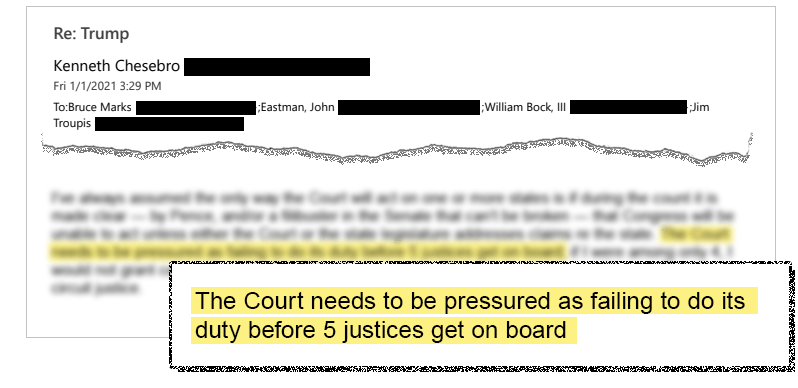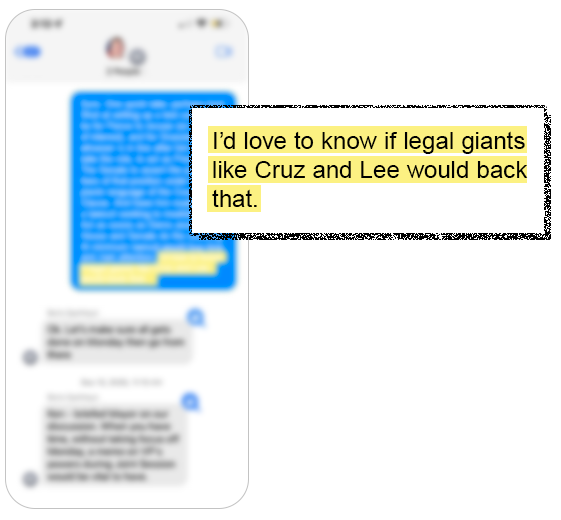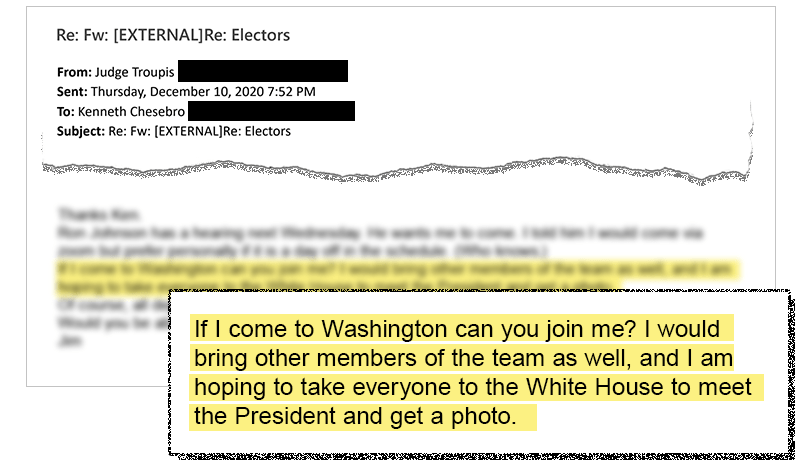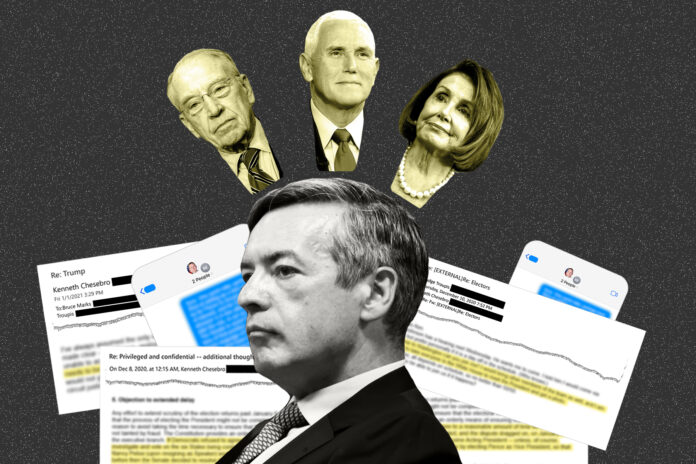Donald Trump’s months-long effort to overturn his defeat in the 2020 election culminated on a single, now-infamous day: Jan. 6.
But there was an alternate scenario gamed out by Trump’s lawyers — one that would have expanded the hours of indecision caused by the Trump campaign’s efforts and stretched out the process for weeks, all the way until Jan. 20, 2021, the Constitution’s ironclad deadline for the transfer of power. If their scheme succeeded, these lawyers hoped, Joe Biden would never take office.
The details of this scheme are being revealed here for the first time. They are drawn from a trove of documents provided to Michigan prosecutors by Trump attorney Kenneth Chesebro, including thousands of pages of emails among Trump’s lawyers, some containing information that has never before been published.
The plan would have seen the Trump campaign pushing Republican lawmakers to prevent Congress from certifying Joe Biden’s win not just on Jan. 6, but for days afterwards. GOP legislators would have feigned confusion over competing slates of electors, paralyzing Congress as the Trump campaign brought increasing pressure on the Supreme Court to step in and resolve the election in their favor.
To do this, Chesebro formulated various ways to invalidate the Electoral Count Act, the law laying out the procedures for Congress to certify the election on Jan. 6. Critically, the law places tight limits on how long individual lawmakers can debate disputed electoral votes — nullifying or inflating those limits, capped at five minutes per member and two hours total, could make Jan. 6 go on indefinitely.
Chesebro wondered at one point whether “legal giants like [Sen. Ted] Cruz and [Sen. Mike] Lee would back” the effort and speculated that delay would finally “force serious review” in Congress of election fraud allegations; John Eastman suggested in talking points aimed at members of Congress that senators could, as a “fallback,” filibuster the five-minutes-per-member rule, turning the possibility of limited debate over several states into a process that could stretch out for an eternity.
TPM obtained the trove of documents after Michigan prosecutors with Attorney General Dana Nessel’s (D) office sent attorneys a tranche of records provided by Chesebro as part of his cooperation with their investigation into the fake electors. Chesebro supplied the documents, which include emails, texts, a 4.5 hour interview, and legal memos, to prosecutors. The records do not provide a comprehensive accounting of the Trump campaign’s entire effort to reverse the President’s loss; they reflect what Chesebro provided as he sought to avoid further prosecution.
On a normal Jan. 6, the Vice President opens the electoral votes submitted by the states. Before a 2022 reform to the Electoral Count Act went into effect, one senator and one representative objecting to a particular state’s results would lead to time-limited debate.
By discarding the Electoral Count Act, Trump campaign lawyers suggested, Republicans in Congress could halt the certification and bring forth endless claims of election fraud in swing states, a process that, according to the documents, Chesebro hoped would create a spectacle, revealing the GOP-friendly Supreme Court as the only rational, functioning actor left standing.
It was a Rube Goldberg device of a plan, and one that sought to use chaos as the invisible force drawing the high court — and whoever else the Trump campaign attorneys believed could resolve the election — into the mess. The hours of violence that ultimately emerged on Jan. 6 as Congress met to certify Biden’s win offer a glimpse of the potential consequences that might have accompanied weeks of delay in formalizing a winner. But for a Trump campaign desperate for a win, extending Jan. 6 to Jan. 20 would allow the high court to serve as a kind of deus ex machina as Congress — and the country — remained mired in strife over the failure to complete the legal formalities around Joe Biden’s election.
Delaying certification of the President for that long may have led to some strange consequences, from the standpoint of the Trump diehards who pushed it: Speaker of the House Nancy Pelosi becoming “acting president” if the election could not be certified, or the Senate electing Mike Pence in Trump’s stead.
“Through delay or chaos they were setting up a constitutional crisis,” said David Becker, a former DOJ attorney who now works on election security with local officials at the Foundation for Election Innovation.
Reacting to the prospect that delay could throw the presidency to Nancy Pelosi, Becker added that “although this was incredibly dangerous and sparked violence, it was also a Keystone Cops operation.”
The nature of exactly what kind of chaos lay at the heart of Chesebro’s plan remains unclear to this day, including whether he envisioned protests or endless procedural delays — or if he had thought through that element of the plan at all. And in the end, Pence did not cooperate, and congressional Republicans only went so far as to object to state electoral slates — not move to overthrow the legal structure underpinning how Congress certified the election.
In a wide-ranging interview with TPM in June 2022 — the only time Chesebro has spoken with the press on the record about his role in the Trump legal strategy — Chesebro disavowed the violence of Jan. 6, saying that it was “the worst possible thing that could have happened” for “lawyers that had serious concerns about the election in several states.” He cast his involvement as “what lawyers do.”
Attorneys for Chesebro downplayed his involvement to TPM, casting him as a lover of legal theory who lacked both the influence and understanding to impact the Trump campaign’s plans. “If you meet him and ask one straightforward question you’ll get 12 different ways it could be,” Chesebro attorney Manny Arora said.
All we need is a little more time to investigate
Chesebro, emails show, sought to take the myth of fraud that Trump had created to its logical conclusion: a stalemate in Congress over the result, and a country without a president-elect. If Congress couldn’t act, the theory went, the Supreme Court would have no choice but to decide the election.
During that critical Jan. 6 to Jan. 20 period, Chesebro envisioned the Trump campaign presenting supposed evidence of voter fraud over and over again, capitalizing on the chaos to make its case while proving that Congress was “unable to act.”
That meant ensuring that the Jan. 6 certification session in Congress essentially never ended. As Chesebro put it to another attorney, “Jan 6 is the real deadline” for certifying the election result. By extension, Chesebro suggested, the Trump campaign could keep the election result up in the air if Congress kept debating the 2020 election result on Jan. 6 without certifying it.
The Electoral Count Act and its time limits were the main obstacle to that. It capped debate at two hours per state, and with seven swing states having submitted fake electors per Chesebro’s plan, that left a relatively measly legal maximum of 14 hours of debate — enough to get the campaign, potentially, into the early hours of Jan. 7, but not enough to reach the acme of a pressure campaign which might take the country to the brink of Jan. 20.
Chesebro argued in a previously unreported Dec. 8, 2020 email to Jim Troupis, a former Wisconsin judge and Trump attorney who had brought Chesebro in to work for Trump, that the Electoral Count Act was a “weapon” for Democrats because it would deny Trump and Pence “the opportunity for the presentation of any evidence (for example, live testimony) regarding the fraud in the election — only limited debate would be allowed.”
“Of course, preventing any sustained public inquiry into the election is key for the Democrats,” he added.
After weeks of failure, Chesebro suggested in early December, the Trump campaign would need an extra potential 14 days in early January to “force serious review in Congress of election fraud in various states.”
Sure, Chesebro conceded in the email, people would complain (“Any effort to extend scrutiny of the election returns past January 6 would be met with the objection that the process of electing the President might not be complete before January 20”), but there was no need to worry: if the “dispute dragged on, on January 20, Nancy Pelosi (upon resigning as Speaker) would become the Acting President — unless, of course, the Senate decided to resolve the impasse by electing Pence as Vice President, so that on January 20 he would become Acting President.”
Troupis replied in the morning that he had mentioned the “Pence angle” to Sen. Ron Johnson (R-WI) to “take his temperature,” and praised the email as an “excellent summary of the end game.”
Destroying the ECA
So, how to turn the Jan. 6 joint session from one day into 14?
In emails and texts to several members of the Trump campaign, Chesebro proposed multiple options for how to bulldoze the ECA and achieve the goal of an extra 14 days without a certified President:
- Mike Pence could decline to open Biden electoral votes — it would be a “fairly boss move,” as Chesebro put it in one email — likely delaying the certification of Biden’s win while posing a core challenge to the ECA.
- A “test case” could be filed before SCOTUS aimed at invalidating the law. It would be filed by Sen. Chuck Grassley (R-IA) acting in Pence’s place as President of the Senate.
- The Senate filibuster could be used as a blunt instrument to block the ECA from either being followed or being implemented on Jan. 6.
Each option involved extending Jan. 6 which, Chesebro argued, would allow Republican senators to present evidence of fraud.
The point of the delay and the fraud discussions, he argued, was not just to draw attention to the Trump campaign’s voter fraud claims, but also to make “clear” to the Supreme Court “that Congress will be unable to act unless either the Court or the state legislature addresses claims re the state,” as he wrote to another attorney in a Jan. 1, 2021 email.

The Pence play
The Pence option was the most straightforward of the three, and the one which Trump, eventually, pursued: Mike Pence would decline to open the votes of states where the fake electors had convened.
Chesebro, Eastman, and Trump’s understanding of the plans for Pence all appear to differ somewhat. But Chesebro articulated his view of how Pence could buy time for the Trump campaign post-Jan. 6 in a Dec. 13 text message to Boris Epshteyn, the Trump attorney.
Pence, per the plan Chesebro proposed, would do what he ultimately refused to do: assert that he had the power to both open and count the votes, and could choose which states not to count — in this case, any state for which the Trump campaign had organized a slate of fake electors. From there, Pence could “force hearings in the States.” (Chesebro did not explain in the documents obtained by TPM how this might work). With time running out in the days before Jan. 20, “the state legislatures would have to appoint electors if they wanted to be counted and avoid the election being thrown to the House,” Chesebro wrote, adding, “if Nancy then refused to hold a vote, Senate would reelect Pence Vice President, and he would become acting president on Jan 20.”
Epshteyn did not immediately reply to the lengthy text from Chesebro that laid out the plan. Hours later, Chesebro followed up to say that he had accidentally deleted a memo further explaining the idea on his hotel computer.
When Chesebro finally sent the memo later that evening, Epshteyn was initially confused: he had received nothing. It then became clear: Chesebro had accidentally sent the memo to Rudy Giuliani, and not Epshteyn.
“Oh…so sorry. My mistake; I mislabeled your texts as his!” Chesebro wrote. “Which is why I addressed email to him; I mistakenly thought he was asking!!”
Epshteyn wasn’t available for comment.
Bringing in Grassley
Failing Pence, Chesebro had another plan to get the ECA invalidated: Sen. Chuck Grassley (R-IA). As president pro tempore, the duty of presiding over the Senate would have fallen to Grassley in Pence’s absence.
Chesebro argued that Pence should recuse because of a conflict of interest — he was involved in the election.
In a separate, Dec. 12 text exchange with Epshteyn and Trump operative Mike Roman, Chesebro argued that Grassley should do exactly what he wanted Pence to do, but then be “ready to file a lawsuit seeking to invalidate the Act as soon as Dems assert the House and Senate do the counting.”
“At minimum lawsuit would buy time and rivet attention,” he added. “I’d love to know if legal giants like [Sen. Ted] Cruz and [Sen. Mike] Lee would back that.”

That option would tee up a Supreme Court “test case,” as Chesebro put it elsewhere in the exchange, forcing the court to rule whether the ECA was constitutional.
In the meantime, congressional Republicans would benefit from the attention that the spectacle attracted via further examinations of supposed fraud in the 2020 election.
Chesebro prepared the memo, sending it to the person he thought was Epshteyn but was, in fact, Giuliani. It’s not clear how far the idea went after that. John Eastman, when asked during his disbarment proceeding whether there were discussions about having Grassley step in for Pence on Jan. 6, cited attorney-client privilege in declining to respond.
Filibustering as the last resort
The last option was the filibuster. Renowned for its ability to gum up the works of the Senate, emails from the trove show that Chesebro and Eastman advocated using it at different points to create mammoth delay.
Chesebro regarded it, according to the document trove, as a means to bulldoze the ECA and get to the legal gray zone of endless delay after Jan. 6. He proposed another aggressive strategy: a senator would withhold unanimous consent to the Concurrent Resolution adopted by the Senate on Jan. 3, which includes the ECA.
He laid out the argument in a Jan. 1 email with “KEY: Critical that a senator object to the concurrent resolution on Jan. 3” as the subject line sent to Epshteyn and Eastman.
“After all, the main REASON to oppose adoption of the Concurrent Resolution, limiting debate to just 2 hours on each state, is that THERE IS SO MUCH TO DEBATE!” Chesebro wrote. “And the way to make that case is to lay out evidence of all the problems in these various states.”
He argued that removing the ECA would then clear the way for indefinite filibusters on Jan. 6, or free up Pence to follow their other instructions. Sens. Josh Hawley (R-MO), Cruz, Lee, and others could, Chesebro theorized, lead an open-ended debate highlighting the Trump campaign’s claims of fraud.
After Epshteyn asked for the argument in a “short, bullet point format,” Eastman followed up with his own synthesis of what Chesebro had written. That omitted Chesebro’s Jan. 3 Concurrent Resolution spitballing, but included the filibuster proposal: that senators should take opportunities to filibuster during the count itself “as a much less enviable fallback.”
‘Sort of unauthorized’
It’s not clear from the trove how far the Trump campaign went in entertaining these proposals. Epshteyn asked if the filibuster emails were “talkers for Congress and Pence,” while Justin Clark, a Trump campaign official, briefly entertained a version of Chesebro’s idea in another thread, writing on Dec. 24 that “it also sounds like Jan 6 is a hard deadline for legal recourse unless congress doesn’t count the votes one way or another.”
Troupis, the former Wisconsin judge who initially brought Chesebro into the Trump legal effort, had maintained a direct line to senior Trump White House officials and to Sen. Ron Johnson (R-WI).
Troupis came back to Chesebro two days after he pitched the Jan. 20 delay plan with exciting news: Sen. Johnson would hold a hearing on Trump’s voter fraud claims later that week — on Dec. 16. There would likely be a photo op with President Trump afterwards; would Ken like to come?

Chesebro traveled to Washington to meet with Trump on Dec. 16 alongside a coterie of other Trump campaign attorneys.
Three years later, in the interview with Michigan prosecutors, Chesebro recalled the meeting with Trump: “The marching orders were, don’t say anything that would make [Trump] feel more positive than he did at the beginning of the meeting.”
He did not follow that advice. Chesebro told prosecutors that he began to speak with Trump after listening to the President talk on speakerphone with Newt Gingrich about something to do with Georgia voting machines. Then, the conversation turned to Trump’s chances in Arizona.
Chesebro did exactly what he had been told not to do: give Trump a sense of hope. He recalled telling Trump that the “real deadline” was Jan. 6. He was later admonished by former White House chief of staff Reince Preibus because, as Chesebro put it later to prosecutors, “the vibe that I had given him was some ground for optimism.”
Chesebro himself compared the meeting to a widely reported and infamous late-night encounter, two days later on Dec. 18, between Trump, Sidney Powell, former Overstock CEO Patrick Byrne, and the White House counsel’s office, saying that it was “sort of unauthorized.”


